Battery acid, scientifically known as sulfuric acid, has a distinct appearance and properties that make it easily identifiable. It is crucial to know what it looks like as it is a dangerous substance that should be handled with extreme care. This article will guide you on how to distinguish battery acid from other substances, ensuring you stay safe when dealing with batteries.
What Is Battery Acid?
Battery acid is an electrolyte solution that is made up of sulfuric acid and water. It has a corrosive, pungent smell and is extremely hazardous to the skin, eyes, and lungs. In its most concentrated form, battery acid can have a pH as low as 0.5 and contain over 30% sulfuric acid by weight.
Battery acid is commonly utilized in lead-acid batteries, including those installed in automobiles and other vehicles. The solution helps to provide a constant flow of electrons for the battery to operate properly.
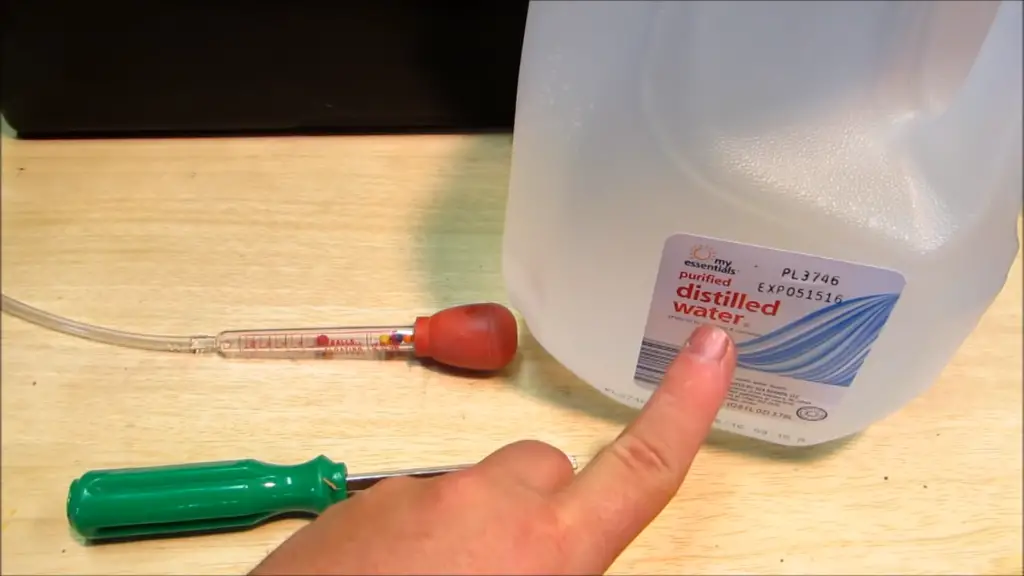
How Can You Tell If There Is Battery Acid Present?
One of the most common signs that there may be battery acid present is corrosion on any metal components near the battery. Corrosion is caused by the acid reacting with metals to form a compound called lead sulfate. Additionally, if there is a strong pungent smell in the area, this could be another indication of battery acid present.
Where Does Battery Acid Come From?
Battery acid is a byproduct of the chemical reaction that takes place in lead-acid batteries. As current passes through the battery, sulfuric acid is produced and mixes with water to form an electrolyte solution. This mixture is then stored in an external container known as an accumulator or vat.
The concentration of the battery acid depends on the charge level of the battery and can range from 0.5 – 1.3 pH (very acidic) to 8.5 – 9.9 pH (very alkaline). Generally, the higher the charge rate of the battery, the more concentrated and acidic the acid will be. [1]
How Can You Safely Handle Battery Acid?
When dealing with battery acid, it is crucial to follow proper safety protocols. It is advisable to wear protective clothing like gloves and a face mask at all times. Furthermore, it is strongly recommended to refrain from attempting any repairs or opening of a lead-acid battery by yourself. These tasks should only be entrusted to a qualified professional.
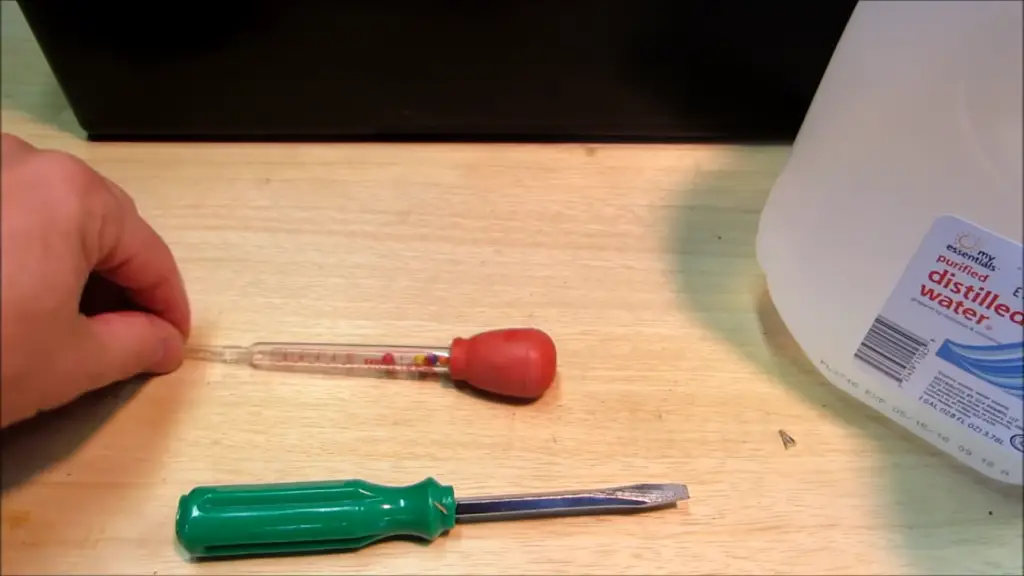
It is also important to remember that battery acid should never be disposed of in the sink or toilet, as it can contaminate the water supply and cause environmental damage. Instead, dispose of it at your local hazardous waste facility.
In the event of an acid spill, it is crucial to promptly neutralize the affected area using baking soda or another appropriate alkaline substance. This proactive measure not only mitigates the potential hazards posed by battery acid but also serves to avert any additional harm.
How Can You Protect Yourself from Battery Acid?
To safeguard yourself from battery acid, it is crucial to observe necessary safety measures while handling it. This entails donning protective clothing, refraining from skin contact, and abstaining from attempting any repairs on a lead-acid battery independently. Furthermore, ensure adequate ventilation in the area and never dispose of battery acid in a sink or toilet.
If there is ever an acid spill, it is important to take action quickly and neutralize the area with baking soda or another suitable alkaline substance. This will help to reduce the risks associated with battery acid and prevent further damage. Finally, it is always a good idea to have an emergency kit ready in case of any unforeseen risks or accidents. [2]
How Can Battery Acid Damage Your Vehicle?
Battery acid can be extremely damaging to your vehicle if not handled properly. The corrosive properties of the acid can eat away at metal components, causing them to rust and corrode faster than normal. Additionally, prolonged exposure to acid can cause the battery terminals and cables to become brittle, leading to electrical failure or other issues with the vehicle’s wiring.
Battery acid can also damage other parts of your vehicle, such as paintwork or interior upholstery. If left unchecked, it can lead to costly repairs down the line. To prevent this from happening, it is important to take the proper safety precautions and never attempt to open or repair a battery on your own.
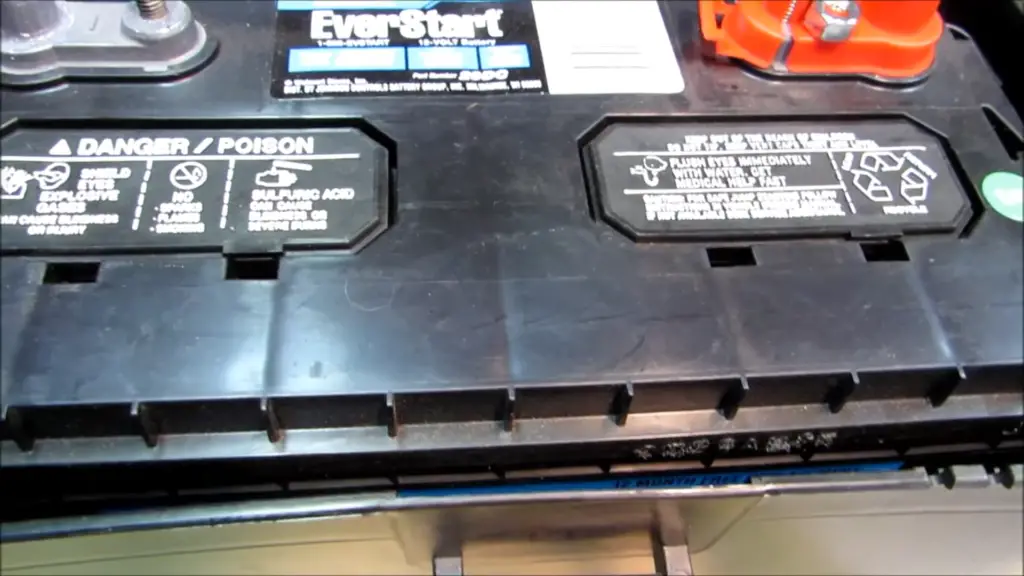
How Can You Prevent Battery Acid Damage?
The best way to prevent battery acid damage is by taking the necessary safety precautions when handling this substance. This includes wearing protective clothing, avoiding contact with the skin, and never attempting to repair a lead-acid battery on your own. It is also important to make sure that the area is well ventilated and that any acid spills are quickly neutralized with baking soda or another suitable alkaline substance.
In addition, it is always a good idea to keep your vehicle’s battery in top condition by monitoring its charge level and checking for signs of corrosion. If you notice any issues with your battery or its cables, it is important to have them addressed as soon as possible in order to prevent further damage from occurring. [3]
Finally, if you are ever unsure about how to handle battery acid safely, it is best to consult a professional before attempting any repairs or maintenance on your own. Doing so can save you time and money in the long run.
What Does Battery Acid Look Like?
Battery acid is a corrosive solution typically ranging in color from transparent to yellowish-brown. It has a very acidic odor and can be hazardous if it comes into contact with the skin or eyes. The concentration of the battery acid depends on the charge level of the battery and can range from 0.5 – 1.3 pH (very acidic) to 8.5 – 9.9 pH (very alkaline).
In order to identify battery acid, it is important to look for signs of corrosion on any metal components near the battery. Additionally, you can use pH test strips or an indicator solution such as phenolphthalein to further confirm that it is present.

What Are Some Alternatives to Battery Acid?
Although battery acid is a commonly used chemical in lead-acid batteries, there are some alternatives that can be used in its place. One such alternative is potassium hydroxide, which is a highly alkaline solution that has been used to increase the performance of lead-acid batteries. Other alternatives include sodium sulfate, calcium nitrate, and magnesium oxide.
In general, these alternatives are much less corrosive than traditional battery acid and may provide additional benefits such as improved durability and increased charge capacity. However, it is important to note that these alternatives are not always suitable for all applications and may require additional modifications to the battery or other components in order to be used safely.
Therefore, it is highly recommended that you consult a professional before making any changes to your vehicle’s battery or attempting any repairs on your own. Doing so can help to ensure that your battery is functioning properly and that you are taking the necessary safety precautions when handling any potentially hazardous materials. [4]
What Are the Benefits of Using Battery Acid Alternatives?
The primary benefit of using battery acid alternatives is increased performance and durability. As mentioned previously, these alternatives may provide a longer lifespan for lead-acid batteries while also increasing their charge capacity. Additionally, they may be less corrosive than traditional battery acid and will not pose the same risks if handled improperly.
Furthermore, using these alternatives can help to reduce environmental impact by eliminating the need for hazardous chemicals in your vehicle’s battery. While this alone should not be a primary motivation for switching from traditional acid, it can be an added bonus for those who are looking to make their vehicles and the environment a bit greener.
Overall, battery acid alternatives offer a number of benefits without sacrificing performance or durability. They can provide a safer and more environmentally friendly option for your vehicle’s battery while still providing the same level of performance as traditional acid.

Effects of Battery Acid and Precautions
Battery acid is a corrosive material that can cause serious damage to skin, eyes, and other tissues when it comes in contact with them. It is important to be aware of the potential effects of battery acid and take precautions if you come into contact with it.
The most common effect of coming into contact with battery acid is chemical burns. These burns can be extremely painful and cause permanent tissue damage. In addition, exposure to battery acid can lead to irritation of the eyes and respiratory system, as well as breathing difficulty if inhaled in large amounts.
In order to protect yourself against potential harm from battery acid, it is important to take proper precautions when handling it. This includes wearing protective clothing such as gloves, a face mask, and eye protection. It is also important to keep battery acid away from any open flames or other sources of heat, as it is highly flammable. Finally, if you do come into contact with battery acid, it is important to immediately flush the affected area with plenty of water and seek medical attention if necessary. [5]
Disposal of Spilled Battery Acid
When dealing with a battery acid spill, it is important to dispose of the material properly. You should never dump it down the drain or into a sewer as this can cause contamination of the water supply. The best option is to take the material to your local hazardous waste facility for proper disposal.
It’s also important to ensure that you avoid contact with the acid. Wear protective clothing such as gloves and eye protection if necessary, and make sure that you thoroughly wash any exposed skin with soap and water immediately after contact.
If the acid was spilled on a surface, it’s important to clean up the spill right away. Wearing protective items such as gloves and eye protection is also advisable in this case. Once the material has been removed, the area should be neutralized with baking soda or a basic solution such as ammonia and water. Then it can be wiped away with a clean cloth.
Finally, it is important to store batteries safely in order to avoid potential spills and other accidents. Always keep your batteries in an insulated container that’s out of reach of children and pets. Make sure that they are stored in a cool, dry place away from sources of heat. If you notice any signs of corrosion or leaking, take the necessary steps to replace the battery right away.
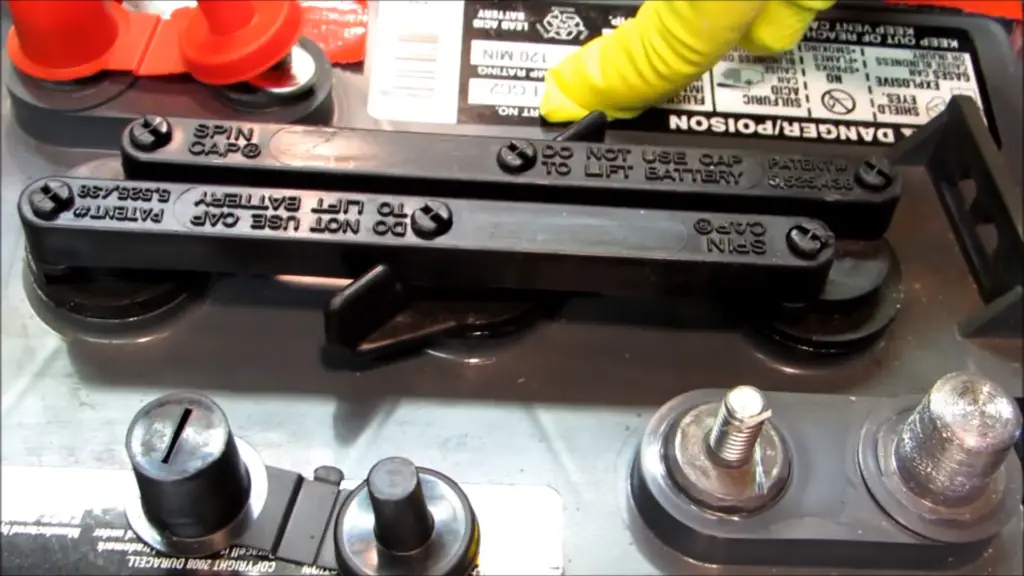
Tips for Working With Batteries and Their Acids
When working with batteries and their acids, it is important to remember a few key safety tips. First, always wear protective clothing such as gloves and eye protection when handling the acid or any of its components. Make sure that you handle the material carefully and avoid contact with your skin. Be sure to read all instructions prior to use and follow them accordingly.
Additionally, it is important to dispose of batteries and their acids responsibly. Never dump them in a sewer or down the drain as this can pollute the water supply. Take them to your local hazardous waste facility instead. It’s also important to store batteries safely in an insulated container, out of reach of children and pets, and away from sources of heat.
Symptoms of Contact with Battery Acid
If you come into contact with battery acid, there are certain symptoms that will typically occur. These include skin irritations such as redness and burning sensations. You may also experience difficulty breathing or a tightness in your chest. It is important to seek medical attention immediately if you have been exposed to battery acid, as the effects can be very serious.
It is also important to remember that battery acid can be extremely corrosive. If it comes into contact with certain materials, such as metal, it can cause them to corrode over time. It can even damage and weaken the structure of certain items, such as vehicles and buildings. Therefore, it is important to take safety precautions when handling or disposing of batteries. [6]
How to Treat Battery Acid Burns
If you have come into contact with battery acid, it is important to seek medical attention as soon as possible. The first step in treating a battery acid burn is to flush the affected area with cold water for at least 20 minutes. This will help to reduce the irritation and pain associated with the burn. You should also remove any clothing or jewelry that may have been contaminated by the acid.
Once the area has been washed and dried, it is important to apply an antibiotic ointment to help prevent infection. You should also cover the affected area with a sterile bandage or gauze pad. If there is any redness or pain in the area after 24 hours, you should consult a doctor as soon as possible.
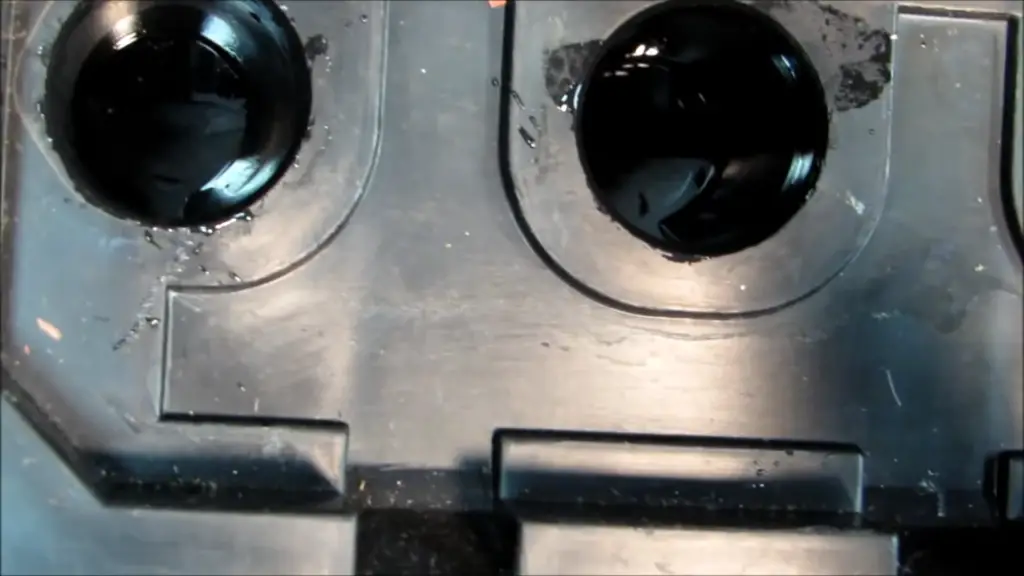
Prevention and Protection Against Battery Acid Exposure
When working with batteries, it is important to take the necessary precautions to protect yourself from battery acid exposure. Here are some tips:
- Wear protective clothing such as rubber gloves and safety goggles when handling batteries.
- Always keep your work area clean and free of spills or other debris that could come in contact with battery acid.
- Make sure your work surface is covered and protected from battery acid splashes.
- Use a face shield if there is a possibility of acid splashing onto your face or eyes.
- Dispose of any used batteries in accordance with local regulations and use appropriate disposal containers for the collection and transport of these hazardous materials.
- Be sure to read and understand the safety precautions on the battery label before use.
- Never try to open a sealed lead acid battery as they contain highly concentrated sulfuric acid which is extremely hazardous.
- Keep all batteries stored in a cool, dry place away from flammable materials and sources of heat or ignition.
- Have an emergency shower and eyewash station readily available in case of accidental exposure.
- Be sure to wash your hands and clothing with plenty of water after exposure to battery acid.
- If you experience any irritation or discomfort, contact a medical professional immediately for further evaluation and treatment.
- If you work with batteries in an enclosed area, be sure to provide adequate ventilation as sulfuric acid fumes can be hazardous if inhaled.
- Lastly, exercise extreme caution when working with batteries to avoid potential injury or illness.
By following these simple safety precautions you can greatly reduce your risk of accidentally coming into contact with battery acid and the harmful effects it may cause. Remember, prevention is always better than cure! [7]
Different Types of Battery Acid
Battery acid is composed of a variety of chemicals, depending on the type and size of the battery. Automobile batteries contain sulfuric acid or lead-acid batteries that are typically diluted with water to create an electrolyte solution. Larger industrial batteries may use hydrochloric acid in place of sulfuric acid, creating a different, more potent toxic mix. Lithium batteries also use electrolytes, but they are usually composed of an organic compound such as propylene carbonate or ethylene carbonate.
FAQs
What does battery acid look like?
Battery acid has a yellowish or brown color. It is usually found in the form of an electrolyte solution, a mixture of sulfuric acid and water.
Is battery acid dangerous?
Yes, battery acid can be very dangerous if not handled with care. Battery acid can cause severe burns on skin contact and inhaling fumes may be harmful to your health. Always take proper safety precautions when working with or around battery acid to avoid potential injury or illness.
How should I dispose of used batteries?
Used batteries should be disposed of in accordance with local regulations and using appropriate disposal containers for the collection and transport of these hazardous materials. Be sure to contact your local waste management authority for specific guidelines on how to properly dispose of used batteries.
What should I do if I experience any irritation or discomfort after coming into contact with battery acid?
If you experience any irritation or discomfort, contact a medical professional immediately for further evaluation and treatment. Be sure to wash your hands and clothing with plenty of water after exposure to battery acid as well. Additionally, have an emergency shower and eye wash station readily available in case of accidental exposure. It is also important to provide adequate ventilation when working with batteries in an enclosed area, as sulfuric acid fumes can be hazardous if inhaled.
What are some tips for preventing battery acid exposure?
When working with batteries, it is important to take the necessary precautions to protect yourself from battery acid exposure. Here are some tips:
- Wear protective clothing such as rubber gloves and safety goggles when handling batteries.
- Always keep your work area clean and free of spills or other debris that could come in contact with battery acid.
- Make sure your work surface is covered and protected from battery acid splashes.
- Use a face shield if there is a possibility of acid splashing onto your face or eyes.
- Dispose of any used batteries in accordance with local regulations and use appropriate disposal containers for the collection and transport of these hazardous materials.
- Be sure to read and understand the safety precautions on the battery label before use.
- Never try to open a sealed lead acid battery as they contain highly concentrated sulfuric acid which is extremely hazardous.
- Keep all batteries stored in a cool, dry place away from flammable materials and sources of heat or ignition.
- Have an emergency shower and eyewash station readily available in case of accidental exposure.
- Be sure to wash your hands and clothing with plenty of water after exposure to battery acid.
- Exercise extreme caution when working with batteries to avoid potential injury or illness.
- Lastly, always seek medical assistance if you experience any irritation or discomfort after coming into contact with battery acid.
Following these simple steps can help prevent any unwanted battery acid exposure and keep you safe while working around batteries.
What are the environmental implications of battery acid disposal?
The improper disposal of battery acid can have serious environmental implications. Battery acid is a hazardous material and needs to be disposed of in accordance with local regulations. Improperly disposing of battery acid can lead to pollution of air, soil and water sources, which can damage plants and animals living in the affected environment. Additionally, leaks or spills of battery acid can cause fires and explosions, leading to further environmental damage.
Useful Video: Checking battery acid levels
Conclusion
Battery acid is an extremely corrosive and hazardous material that can cause serious health issues if it comes into contact with the skin or is inhaled or ingested. It should be handled with extreme care and disposed of properly to prevent potential injuries. To identify battery acid, look for signs such as a yellowish-green liquid, having a sour smell like vinegar, and feeling slippery to the touch. Make sure to always wear proper protective gear, such as gloves and a face mask, when handling battery acid. Knowing what battery acid looks like is essential for the safe storage and disposal of this hazardous material.
References
- https://www.generationsolar.com/batteries/battery-acid-is-cloudy/
- https://www.drillanddriver.com/what-does-battery-acid-look-like/
- https://www.uetechnologies.com/what-color-is-battery-acid/
- https://conquerallelectrical.ca/what-does-battery-acid-look-like/
- https://www.doityourself.com/stry/what-does-battery-acid-look-like
- https://www.tycorun.com/blogs/news/how-to-spot-battery-leaking-acid-helpful-guide-to-dispose-a-leaking-battery
- https://www.healthline.com/health/battery-acid-on-skin





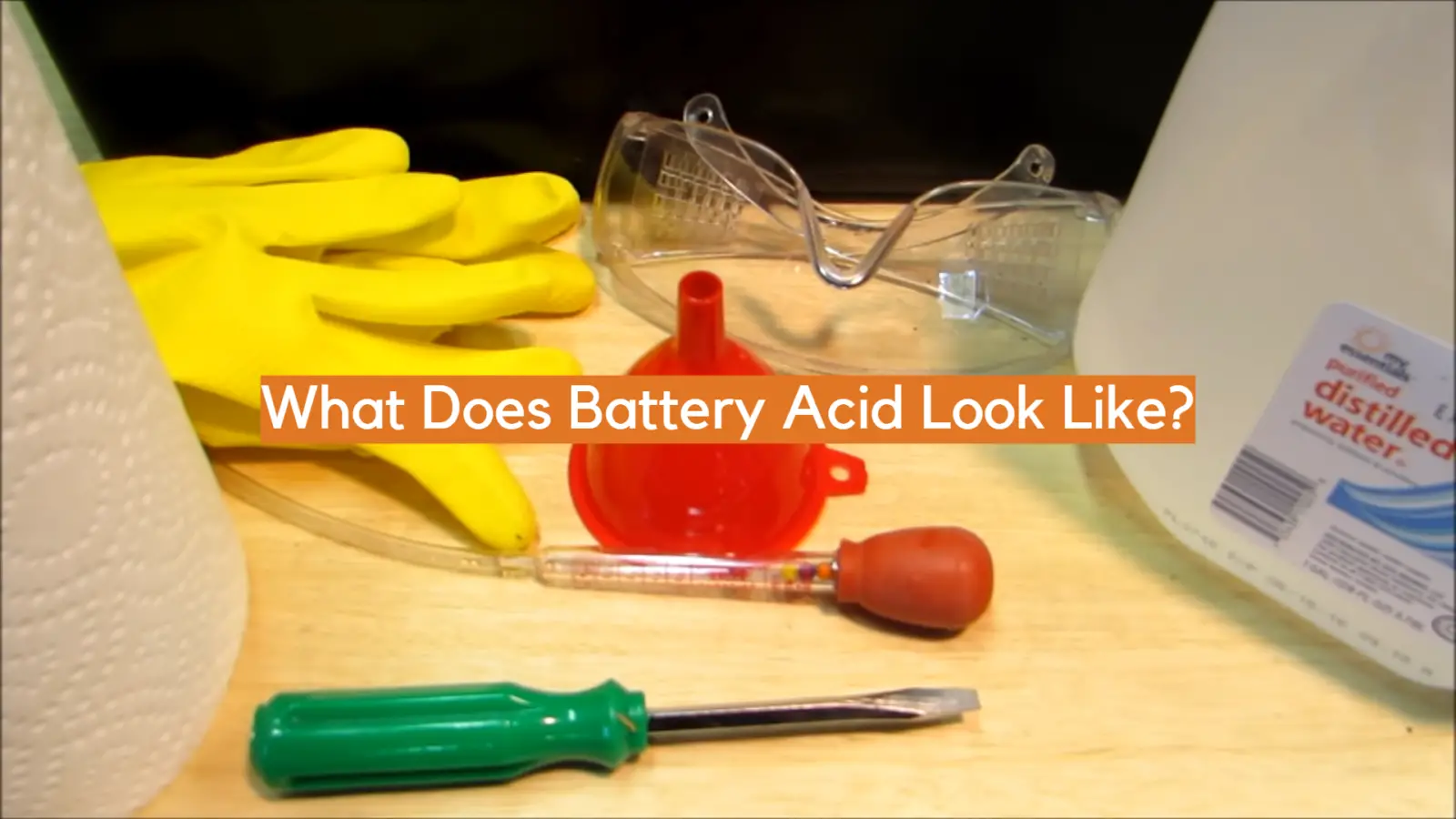








Leave a Reply